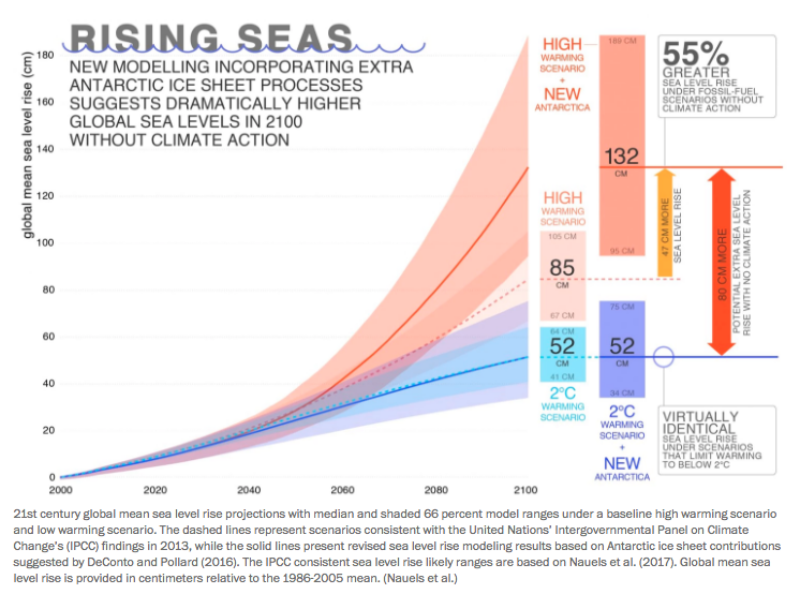Sea levels could rise by 1.3m in 2100 without climate action – new study
Share

We can only limit sea level rise to around half a meter by 2100 if cumulative carbon emissions stay below 850 gigatonnes and coal is nearly phased out by 2050. If emissions continue unchecked, oceans could rise 55 per cent more than previously thought – by around 130cm in 2100, according to a paper published in Environmental Research Letters today.
By incorporating latest findings on Antarctic ice sheet dynamics into new sea level rise modelling, the study “Linking sea level rise and socioeconomic indicators under the shared socioeconomic pathways” yields markedly higher sea level rise projections for business as usual scenarios than the Fifth Assessment Report (AR5) of the Intergovernmental Panel on Climate Change.
The researchers paired their sea level rise model with the new generation of scenarios – Shared Socioeconomic Pathways (SSPs) – being developed for the IPCC Sixth Assessment Report (AR6), due in 2021, and compared them with outcomes for the previous generation of scenarios – Representative Concentration Pathways (RCPs), used in the last IPCC Assessment (AR5).
They found that under these new scenarios, sea level rise projections could be limited to around 50 cm if 2050 cumulative CO2 emissions stay below 850GtC, with a global phase-out of coal nearly completed by that time. The underlying pathways would be compatible with limiting warming to below 2°C. Without any mitigation, sea levels could rise by an average of 132 cm in 2100 [likely range: 95 to 189 cm] relative to the 1986-2005 mean.
“Antarctica is clearly responsible for a sea level rise risk of almost 2m until 2100 if we do not protect the climate”, says Dr Matthias Mengel, co-author of the study and working at Potsdam Institute for Climate Impact Research. “We have to aim for as much mitigation as we can and we also need to better understand what is going on in Antarctica to minimise this risk.”
“The methods we use show that rapid discharge from the Antarctic ice sheet could be triggered already at around 1.9°C warming above pre-industrial levels” said lead author Alexander Nauels from the Australian-German Climate & Energy College at The University of Melbourne. “So the 1.5°C limit in the Paris Agreement is a much safer bet to avoid this additional contribution than only achieving 2°C.”
The new generation scenarios (SSPs) provide information about socioeconomic assumptions that are driving changes in emissions, such as population, GDP growth, and urbanisation dynamics, allowing researchers to relate sea level rise to socioeconomic metrics, including carbon prices.
“If we have a carbon price of $100 USD (2005 equivalent) in 2050, according to the SSP scenarios, we could limit sea level rise to around 65cm by 2100,” said co-author Dr Carl Friedrich Schleussner from Climate Analytics. “This is the first time that a study has combined latest sea level rise modelling with the new scenarios and we can see clear linkages between specific mitigation efforts and sea level rise impacts.”
STUDY
Linking sea level rise and socioeconomic indicators under the shared socioeconomic pathways, Alexander Nauels et al 2017 Environ. Res. Lett. 12 114002











